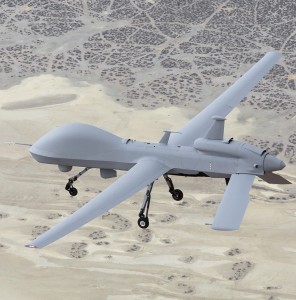Improved Gray Eagle to face critical demo
It’s looking like the Pentagon won't be able to afford lots of radically new unmanned planes, so General Atomics Aeronautical Systems has adopted a commonsense strategy: Why not convince military customers to improve the models they already have?

Built on speculation: Improved Gray Eagle's first flight July 26. (Credit: General Atomics Aeronautical Systems)
On the Air Force side, Pentagon intelligence chief Michael Vickers returned from a visit to the San Diego company last year supporting a proposal to retrofit Reaper planes with longer wings, wing-mounted fuel pods and heavier landing gear to support the additional weight.
Now it's the Army’s turn.
General Atomics spent internal research and development dollars building a longer endurance version of the Army’s Predator-inspired Gray Eagle. It's now preparing to demonstrate the Improved Gray Eagle, or IGE, in front of the Army later this year.
The Army is sure to be paying attention. The plane will be powered by an Alternate Heavy Fuel Engine the Army paid for as a potential upgrade to the Gray Eagle engines. Heavy fuel means diesel aviation fuel, rather than the gasoline that powered early unmanned planes. Heavy fuel is higher energy and easier to deliver to the field because so many jets and helicopters already use it.
The Army says it’s interested in the "overall improvement that IGE could potentially provide.” It also cautions that there’s no money in the current acquisition strategy for an Improved Gray Eagle.
General Atomics and the Army are just now in negotiations on a contract to start full-rate production of Gray Eagles, versions of which have been flying since 2008. General Atomics hopes to seal the contract this month.
The company flew the IGE demonstrator for first time on July 26 from its Flight Operations Facility in Palmdale, Calif.
The plane has a deeper belly than the existing Gray Eagles to carry 50-percent more fuel, plus it has an improved centerline hard point that can support either a 500-pound external fuel pod or a larger sensor.
General Atomics calculates that with the fuel pod the IGE should be able to fly for 45 hours in an intelligence, surveillance, reconnaissance configuration, compared to the currently marketed endurance of 25 hours.
Customers would have the option of dedicating some of the additional space for a damage tolerance computer or a traffic collision avoidance system.
Engineers went with a deeper fuselage instead of longer wings so that the planes wouldn't take up any more room on a crowded flight line.
General Atomics says it hopes “to go on contract with the Army for IGE production following a successful demo."


